Kazan digital crossroads: how road safety technologies are introduced in the city
Kazan launched the country's first digital crossroads , which should increase road safety.

Source: mic.tatarstan.ru
The new complex consists of an outdoor “traffic light under your feet”, LED road indicators, an electronic speed display, a duplicate traffic light of an RGB LED strip, an intelligent pedestrian warning system, a laser stop line, stand-alone road bump indicators and many other technical solutions.
An intersection equipped with similar developments draws the attention of traffic participants to the situation on the road. According to the general director of Zarnitsa, the company that created the complex, Arthur Abdulzyanov, its cost is 2.8 million rubles, annual maintenance of the intersection will cost 150 thousand rubles.
The manufacturers of the complex note that the digital intersection creates a predictable and orderly traffic situation, thereby reducing the "level of stress, panic and uncontrolled and dangerous behavior" on the road. The crossroads operates in Kazan near the "Chalice" (Kazan registry office in the form of a huge chalice) - at the intersection of Dekabristov - Sibgat Hakim - Komsomolskaya streets.

Source: Events
The project is a Russian development taking into account the practices of France and the USA. According to Arthur Abdulzyanov, the creators of the intersection did not meet another such complex in the world, with the exception of certain elements. In Kazan, the crossroads has combined a variety of road safety technologies.
Outdoor “traffic light under your feet”
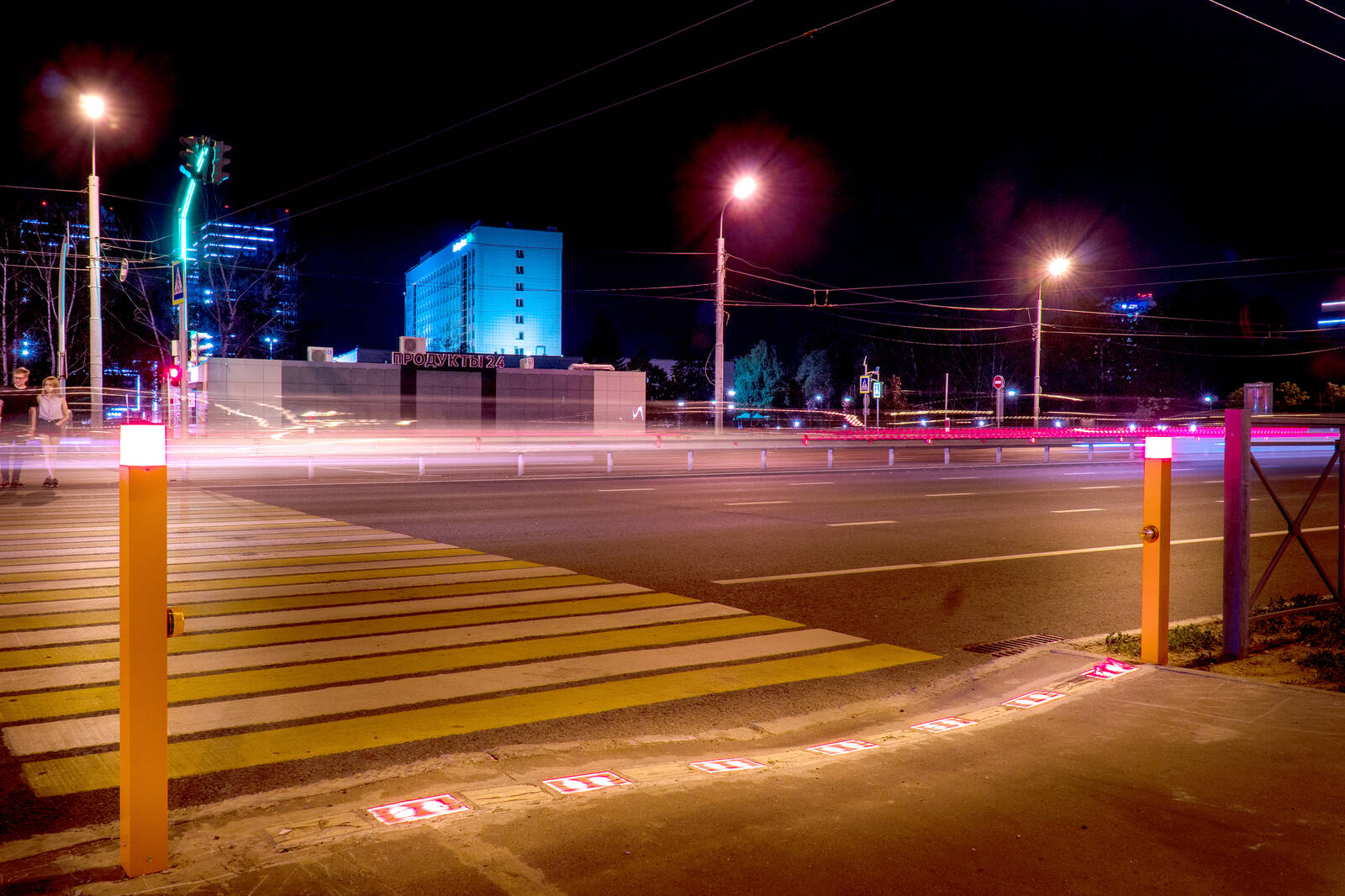
As the representative of the Zarnitsa company explained to Habru, this traffic light is an additional illumination mounted in the sidewalk before the transition, which works synchronously with a regular traffic light. “Traffic light under your feet” serves as an additional signal to attract the attention of people who do not tear themselves away from the smartphone screen even during the passage of the carriageway and children, as it involves peripheral vision. The bulbs light up red or green.
LED road indicators
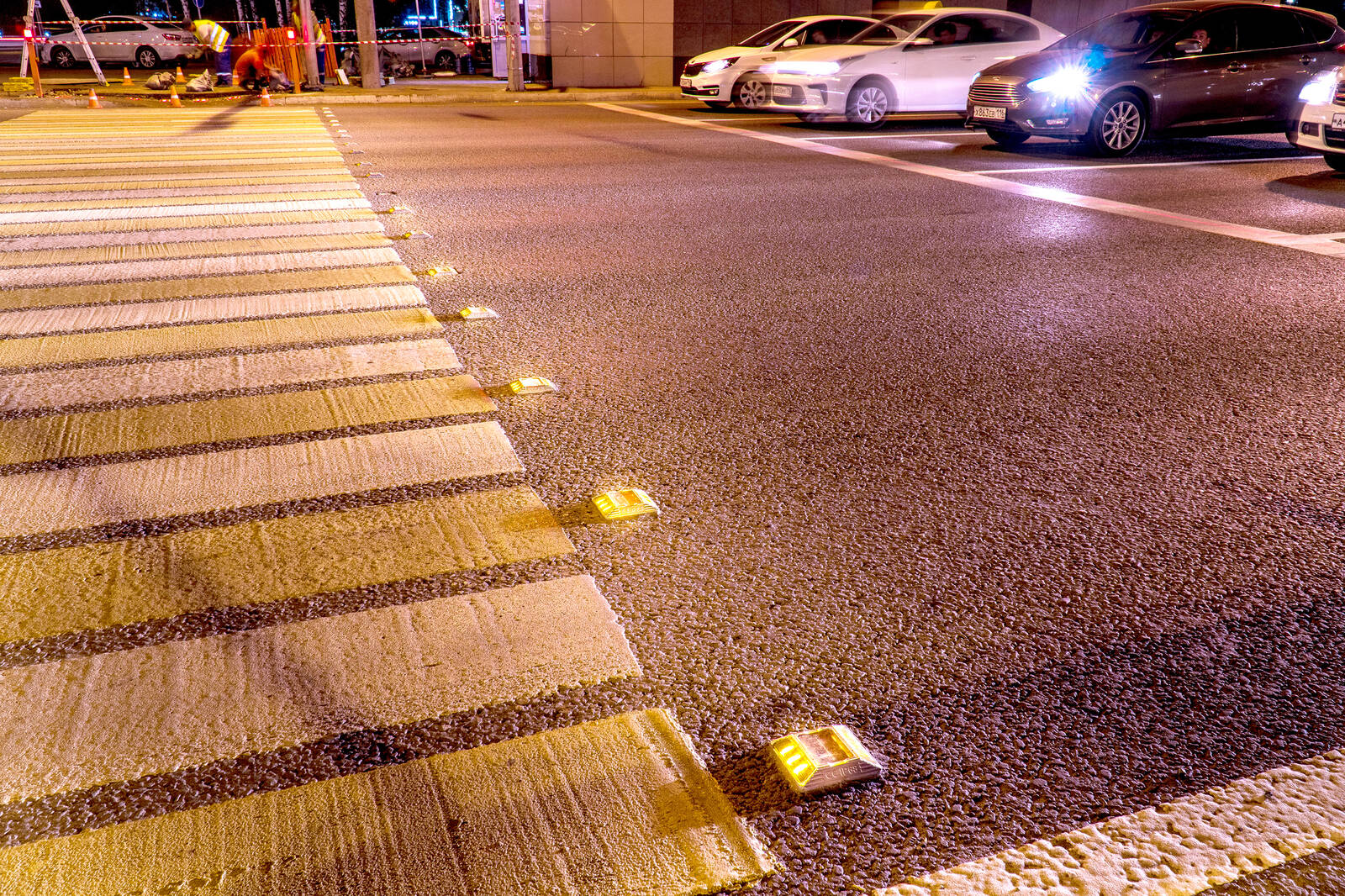
This is an additional highlight of the transition itself. Indicators are mounted before marking on the side of the roadway, powered by solar panels. They improve the visibility of the transition in the dark.
Electronic board of measurement of speed
An LED screen was installed on the side of the road, which displays the permissible speed in this area. If the driver has exceeded the speed, the traffic signs “Traffic light regulation”, “Pedestrian crossing” and the inscription “Exceeded speed limit” light up and blink on the screen. Penalties for excesses will not come, since the data from the scoreboard are advisory in nature.
Duplicating traffic light LED RGB tape
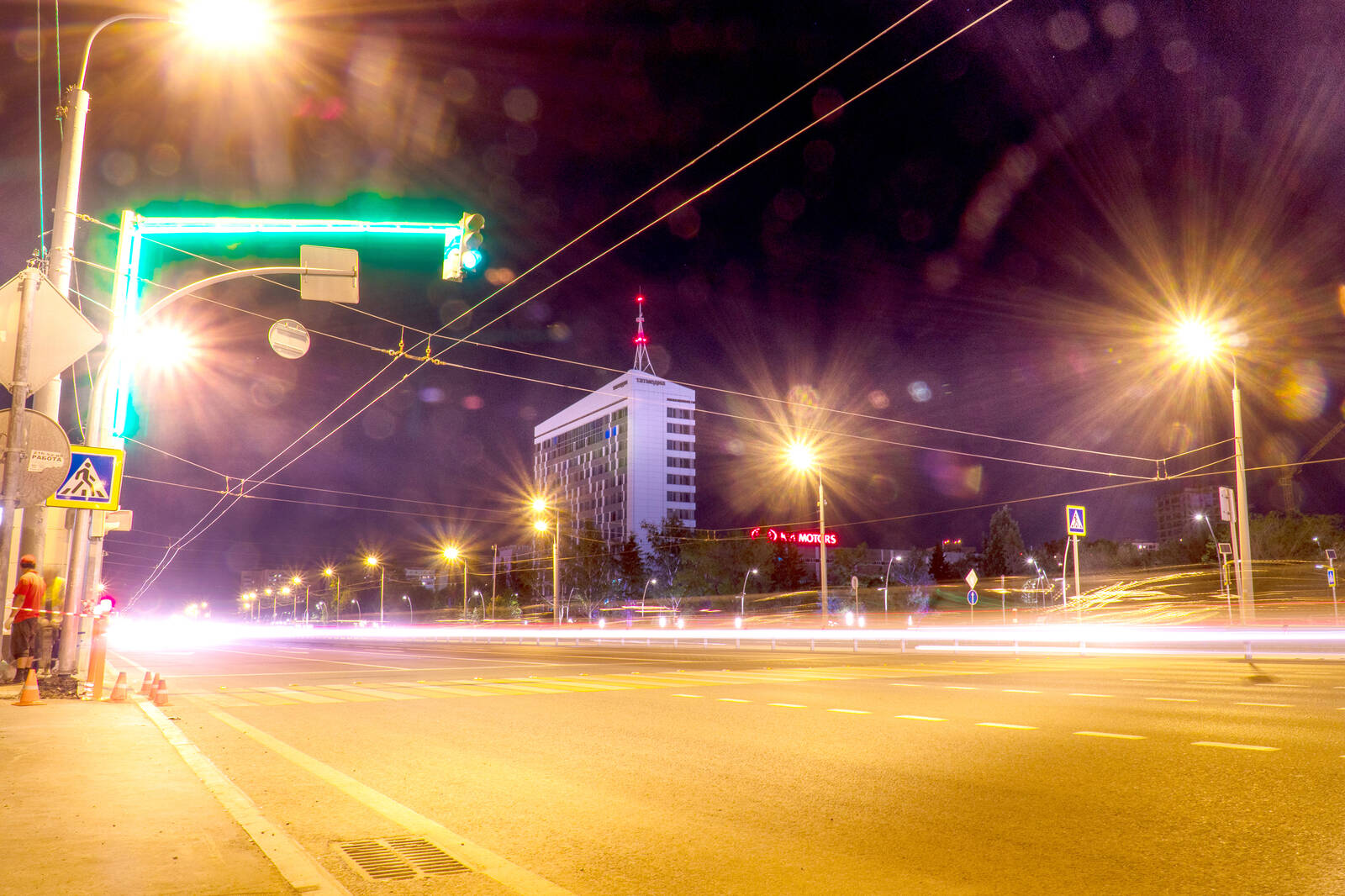
The LED strip is mounted on a support structure, to which a traffic light is attached and duplicates its signals. Due to this, good visibility of signals in any weather, dark time of the day and in any position on the road is achieved.
Pedestrian Warning System

Sensors are installed before the transition, a laser beam passes between them. If a person passes through this line at a red traffic light, a voice alert is triggered. A pedestrian will be advised to wait for the green signal and only then cross the road. At night, the columns on which the sensors are installed work like bright lights. According to Arthur Abdulzyanov, the company found this development in France.
Laser stop line
The stop line is mounted in the roadway. It will be triggered for drivers with a prohibiting traffic signal. It can be clearly seen in the dark, during snowdrifts, as well as in situations where it is difficult to make out road markings.
Autonomous indicators of a road chipper
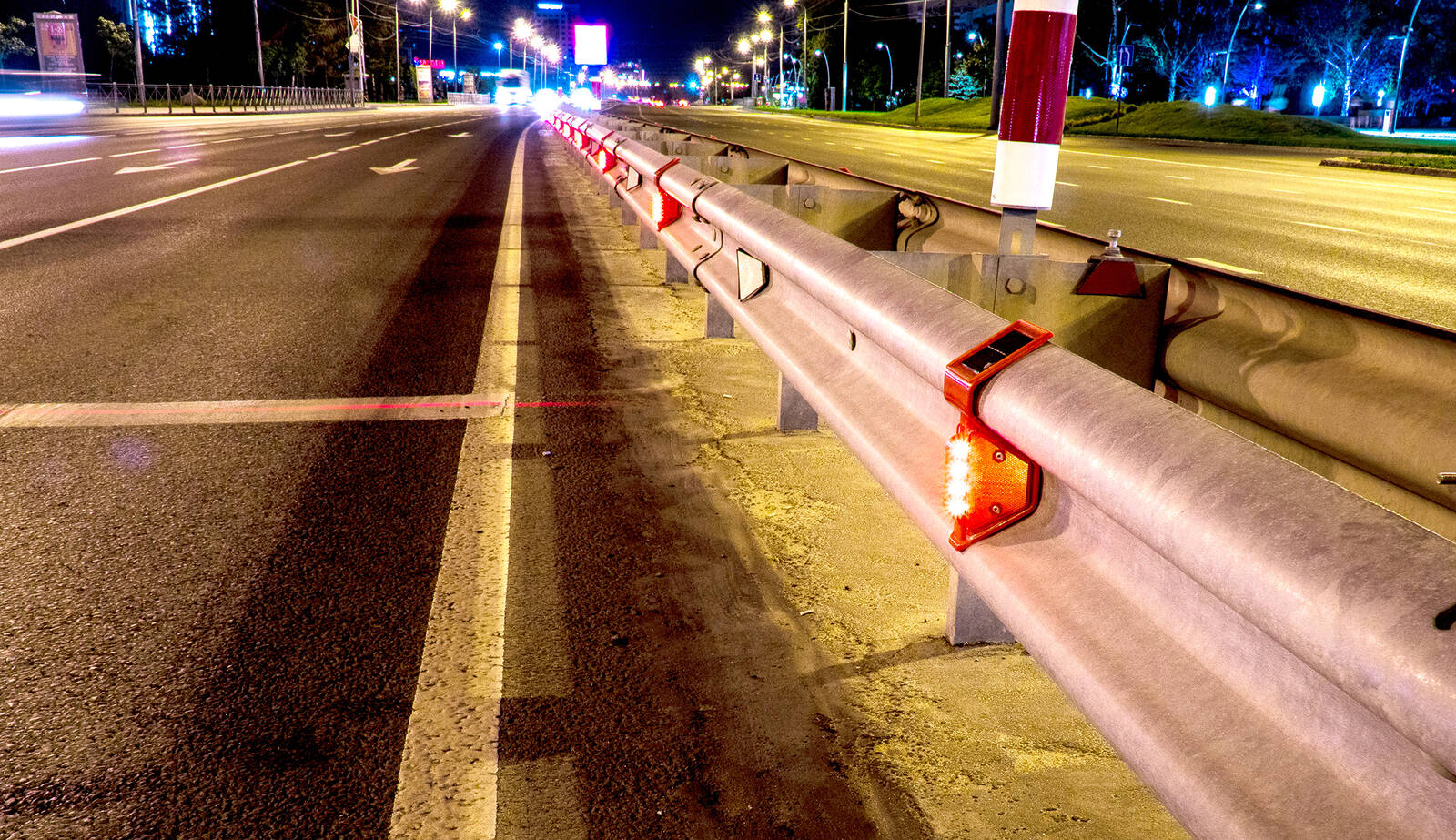
Indicators create better visibility of horizontal road marking elements in the dark. Run on solar panels.
Automatic flicker output
Near the intersection there is a device with flickers - retroreflective stickers. According to Arthur Abdulzyanov, their cost is about 20 rubles. Money from the sale of flickers will go to a charity fund.
Tactile tile
For pedestrians with visual impairments, a tactile tile with embossed protrusions is installed to help navigate the space.
Solar floodlight
An additional solar-powered backlight is installed at the intersection, which improves the visibility of road signs in the dark.
By the end of the year, the digital crossroads will operate in test mode. In the future, Zarnitsa plans to raise the issue of regulatory regulation of the use of such complexes on the streets on an industrial scale. (The head of the company Artur Abdulzyanov is also a deputy of the State Council of Tatarstan).
The expert of the NTI Avtonet working group and GLONASS NP Vadim Sakhonko confirms that the struggle for road safety is a trend of recent decades. In 2018, according to traffic police statistics, 18,214 people died in Russia as a result of an accident. This is almost 50 people a day, he notes.
He notes that sensors built into the roadway use technologies such as an inductive loop, magnetometer, magnetic sensor, or magnetic detector.
The sensors that are located above the roadway are most often video detection systems, a shortwave presence detection radar, a Doppler sensor, an acoustic sensor, lidar, passive infrared radiation and ultrasound.

In general, the Kazan digital crossroads, along with the usual Moscow crossroads, are at the forefront of Russian trends in the application of new rules, laws, methods and technologies. It’s worth adding the primacy of the city in the appearance of dedicated lanes for public transport (they appeared in Kazan earlier than in Moscow), the appearance and development of cameras, testing new solutions (for example, cameras at medium speed), says the head of shtrafy-gibdd .ru Vasil Zakiev.
Anton Glukhov, editor-in-chief of the publication “Traffic police fines”, said that over the past ten years, a number of innovations have been introduced at the intersections of Kazan:
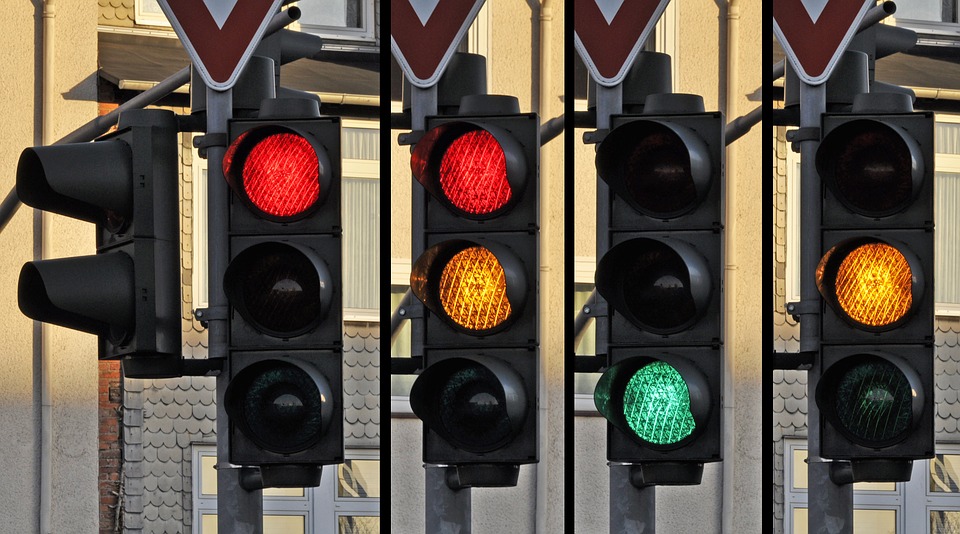
Anton Glukhov believes that in Kazan, based on popularity at the crossroads of Western countries, one can expect such new items:
According to Vadim Sakhonko, the digital Kazan intersection or its elements can be distributed throughout the country only according to the results of the test period.
Vasil Zakiev believes that for safety on the roads you need to use simple and cheap solutions.

Source: mic.tatarstan.ru
The new complex consists of an outdoor “traffic light under your feet”, LED road indicators, an electronic speed display, a duplicate traffic light of an RGB LED strip, an intelligent pedestrian warning system, a laser stop line, stand-alone road bump indicators and many other technical solutions.
An intersection equipped with similar developments draws the attention of traffic participants to the situation on the road. According to the general director of Zarnitsa, the company that created the complex, Arthur Abdulzyanov, its cost is 2.8 million rubles, annual maintenance of the intersection will cost 150 thousand rubles.
The manufacturers of the complex note that the digital intersection creates a predictable and orderly traffic situation, thereby reducing the "level of stress, panic and uncontrolled and dangerous behavior" on the road. The crossroads operates in Kazan near the "Chalice" (Kazan registry office in the form of a huge chalice) - at the intersection of Dekabristov - Sibgat Hakim - Komsomolskaya streets.

Source: Events
The project is a Russian development taking into account the practices of France and the USA. According to Arthur Abdulzyanov, the creators of the intersection did not meet another such complex in the world, with the exception of certain elements. In Kazan, the crossroads has combined a variety of road safety technologies.
Outdoor “traffic light under your feet”

As the representative of the Zarnitsa company explained to Habru, this traffic light is an additional illumination mounted in the sidewalk before the transition, which works synchronously with a regular traffic light. “Traffic light under your feet” serves as an additional signal to attract the attention of people who do not tear themselves away from the smartphone screen even during the passage of the carriageway and children, as it involves peripheral vision. The bulbs light up red or green.
LED road indicators

This is an additional highlight of the transition itself. Indicators are mounted before marking on the side of the roadway, powered by solar panels. They improve the visibility of the transition in the dark.
Electronic board of measurement of speed
An LED screen was installed on the side of the road, which displays the permissible speed in this area. If the driver has exceeded the speed, the traffic signs “Traffic light regulation”, “Pedestrian crossing” and the inscription “Exceeded speed limit” light up and blink on the screen. Penalties for excesses will not come, since the data from the scoreboard are advisory in nature.
Duplicating traffic light LED RGB tape

The LED strip is mounted on a support structure, to which a traffic light is attached and duplicates its signals. Due to this, good visibility of signals in any weather, dark time of the day and in any position on the road is achieved.
Pedestrian Warning System

Sensors are installed before the transition, a laser beam passes between them. If a person passes through this line at a red traffic light, a voice alert is triggered. A pedestrian will be advised to wait for the green signal and only then cross the road. At night, the columns on which the sensors are installed work like bright lights. According to Arthur Abdulzyanov, the company found this development in France.
Laser stop line
The stop line is mounted in the roadway. It will be triggered for drivers with a prohibiting traffic signal. It can be clearly seen in the dark, during snowdrifts, as well as in situations where it is difficult to make out road markings.
Autonomous indicators of a road chipper

Indicators create better visibility of horizontal road marking elements in the dark. Run on solar panels.
Automatic flicker output
Near the intersection there is a device with flickers - retroreflective stickers. According to Arthur Abdulzyanov, their cost is about 20 rubles. Money from the sale of flickers will go to a charity fund.
Tactile tile
For pedestrians with visual impairments, a tactile tile with embossed protrusions is installed to help navigate the space.
Solar floodlight
An additional solar-powered backlight is installed at the intersection, which improves the visibility of road signs in the dark.
By the end of the year, the digital crossroads will operate in test mode. In the future, Zarnitsa plans to raise the issue of regulatory regulation of the use of such complexes on the streets on an industrial scale. (The head of the company Artur Abdulzyanov is also a deputy of the State Council of Tatarstan).
The expert of the NTI Avtonet working group and GLONASS NP Vadim Sakhonko confirms that the struggle for road safety is a trend of recent decades. In 2018, according to traffic police statistics, 18,214 people died in Russia as a result of an accident. This is almost 50 people a day, he notes.
“Basically, decisions are now being introduced in Russia that make it possible to write a fine for violating traffic rules. In the world in terms of intersection management, sensors are used installed in the carriageway and over the carriageway, ”says Vadim Sakhonko.
He notes that sensors built into the roadway use technologies such as an inductive loop, magnetometer, magnetic sensor, or magnetic detector.
The sensors that are located above the roadway are most often video detection systems, a shortwave presence detection radar, a Doppler sensor, an acoustic sensor, lidar, passive infrared radiation and ultrasound.
“Each technology has its pros and cons. For example, sensors installed in the carriageway are cheaper than those installed above the surface. However, for their installation and repair it is necessary to block the movement, they are subject to wear and tear, and the accuracy of their work depends on the qualifications of the company that made the installation.
In each case, the solution is selected individually depending on the tasks. For this, it is necessary to build a dynamic transport model and use modern automated traffic control systems of the ASUDD, ”says Vadim Sakhonko.

In general, the Kazan digital crossroads, along with the usual Moscow crossroads, are at the forefront of Russian trends in the application of new rules, laws, methods and technologies. It’s worth adding the primacy of the city in the appearance of dedicated lanes for public transport (they appeared in Kazan earlier than in Moscow), the appearance and development of cameras, testing new solutions (for example, cameras at medium speed), says the head of shtrafy-gibdd .ru Vasil Zakiev.
“A few years ago, large cities of Russia and, above all, Moscow reached the limits of saturation of their street-road network with personal cars. There was a public request for a change in the situation. Leading architects and urbanists have joined in the analysis and development of the strategy. The general course was taken on the transfer of Western European experience. Other large cities began to catch up with the capital, ”explained Vasil Zakiev.
Anton Glukhov, editor-in-chief of the publication “Traffic police fines”, said that over the past ten years, a number of innovations have been introduced at the intersections of Kazan:
- speed limit in the city to 40 km / h;
- sound vibration strips on asphalt in front of major intersections (Pavlyukhina St. intersection with Daurskaya St.);
- waffle marking (Pravo-Bulachnaya St. and Levo-Bulachnaya St.), coupled with a complex of photo-video recording violations of the rules of the intersection;
- sensational experiment with the sign "right turn" on a red light (Dekabristov St.);
- yellow-white zebra at the crossroads (Kazan was an experimental region);
- pedestrian crossings raised above the level of the road - traffic police;
- fences at crossings / intersections;
- color repeaters of traffic signals on poles and poles (first appeared in Kazan in 2018 at the intersection of Lobachevsky St. and Kremlyovskaya St.);
- narrowing of traffic lanes (cheaply increases throughput and reduces speed);
- avoiding left turns (a case in point of Vishnevsky St. - Schmidt St.);
- duplication of traffic lights at major intersections / introduction of hanging high-altitude traffic lights at the bars;
- yellow zigzag line to stop public transport;
- traffic lights with built-in counters of signal duration;
- transfer of stoppages deep into the streets from intersections;
- road cameras.

Anton Glukhov believes that in Kazan, based on popularity at the crossroads of Western countries, one can expect such new items:
- path curvature - slowing down access roads to the intersection;
- change in levels - a pedestrian crossing is carried out just above the plane of the road;
- smaller road signs in the historic center;
- security islands;
- different types of coatings - changing coatings draws the driver’s attention to the road;
- color contrasts of the road surface - also attract attention;
- visual purity - a minimum of distractions at intersections;
- narrowing of roads in front of places of accident concentration;
- avoiding wide multi-lane roads;
- columns
- the use of chicanes (smooth bends of the road, forcing to reduce speed).
According to Vadim Sakhonko, the digital Kazan intersection or its elements can be distributed throughout the country only according to the results of the test period.
“Some elements that have proven their effectiveness will find their application. I believe that smart traffic lights will take their place in the urban transport infrastructure as an element of automatic, adaptive traffic control. It is necessary to wait for the results of this intersection to draw any conclusions, ”said Vadim Sakhonko.
Vasil Zakiev believes that for safety on the roads you need to use simple and cheap solutions.
“We are at such a stage in the development of the urban environment that decisions to reduce accident rates are often quite cheap, but they are also very effective. Over the previous thirty years of neglecting road problems, the potential for simple measures has accumulated.
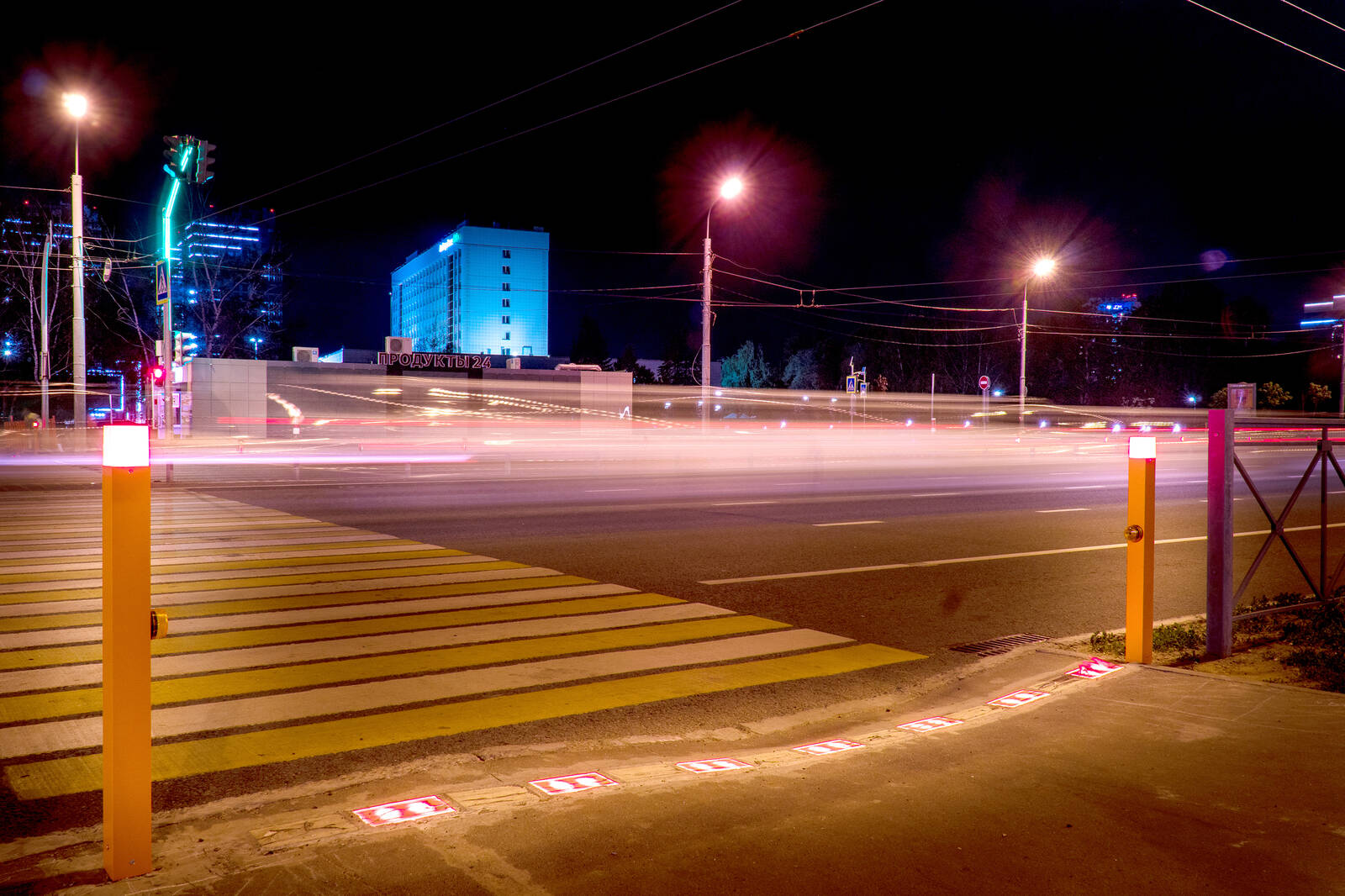
Narrowing of lanes, decrease in flow velocity due to signs, pedestrian crossings raised 10-15 cm above the road level, bends of the carriageway due to alternately organized parking lots to the left and right of the driver - such measures do not require additional funding, however, from experience close to us Eastern European countries are able to bring a real reduction in deaths and injuries on the roads. Moreover, practice shows that the widespread decrease in speed in large cities does not slow down the duration of a trip by private car as a whole. There is no furious speed in one place, but there are no traffic jams in another, ”Vasil Zakiev summed up.
All Articles